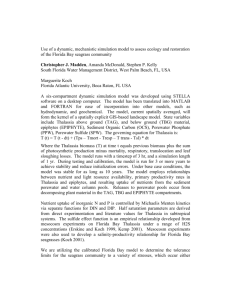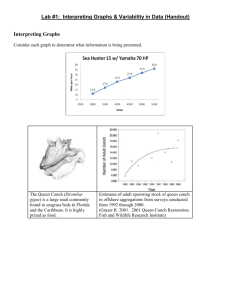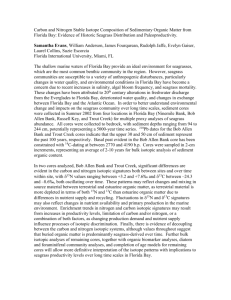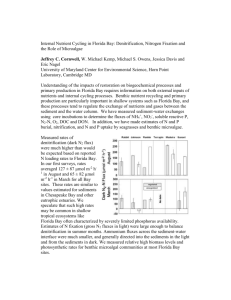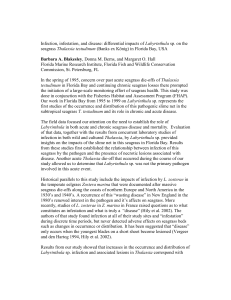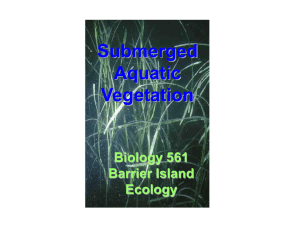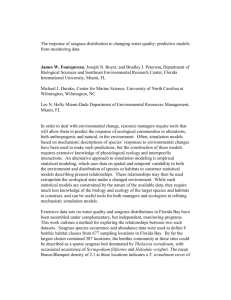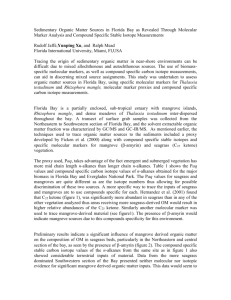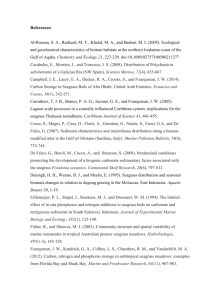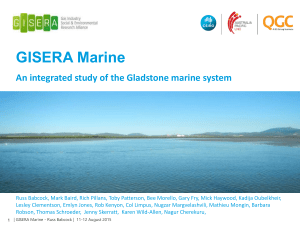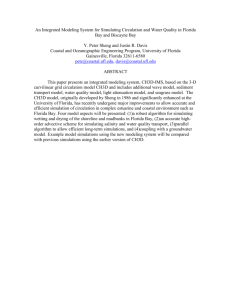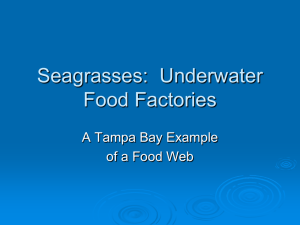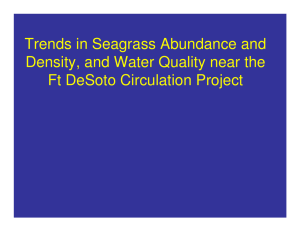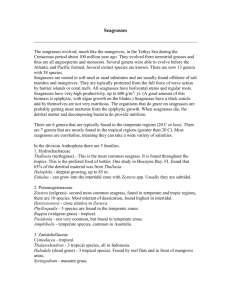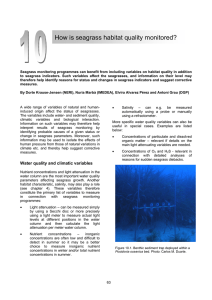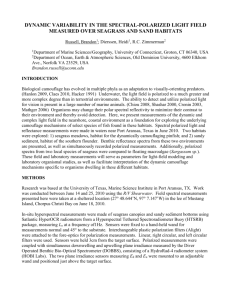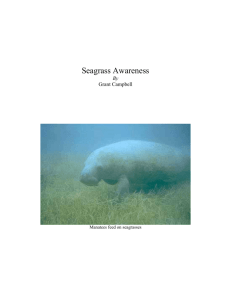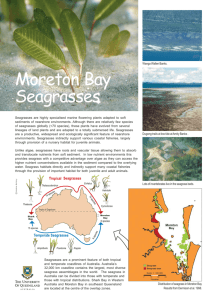A Model of Seagrass Dynamics in Florida Bay: Evaluation and
advertisement
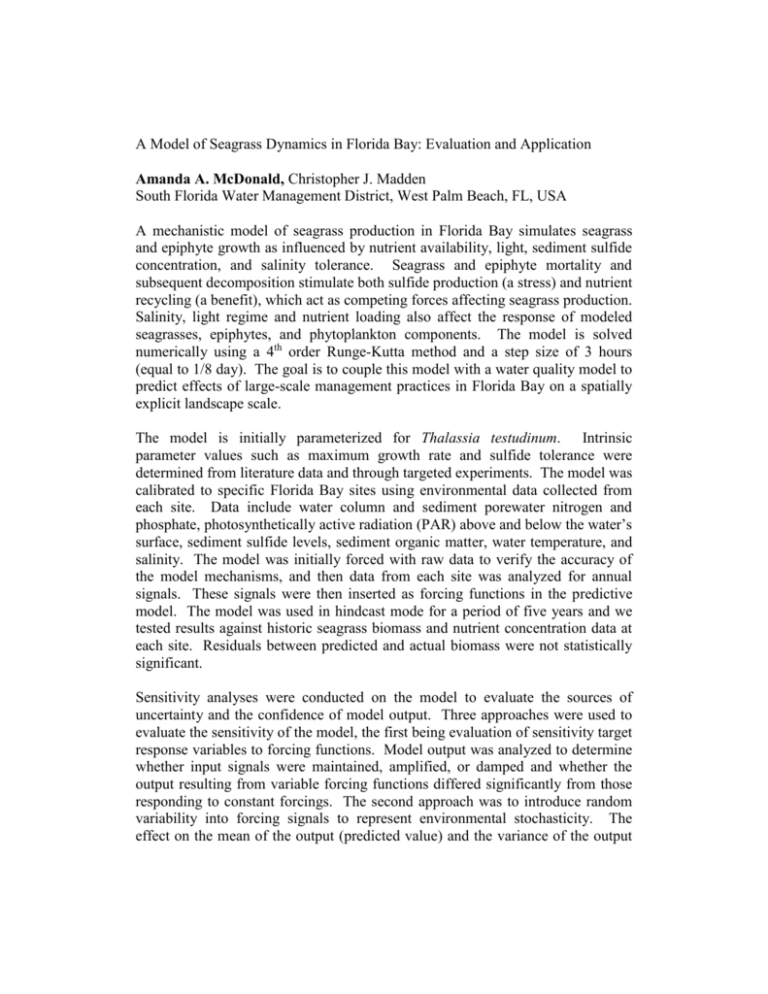
A Model of Seagrass Dynamics in Florida Bay: Evaluation and Application Amanda A. McDonald, Christopher J. Madden South Florida Water Management District, West Palm Beach, FL, USA A mechanistic model of seagrass production in Florida Bay simulates seagrass and epiphyte growth as influenced by nutrient availability, light, sediment sulfide concentration, and salinity tolerance. Seagrass and epiphyte mortality and subsequent decomposition stimulate both sulfide production (a stress) and nutrient recycling (a benefit), which act as competing forces affecting seagrass production. Salinity, light regime and nutrient loading also affect the response of modeled seagrasses, epiphytes, and phytoplankton components. The model is solved numerically using a 4th order Runge-Kutta method and a step size of 3 hours (equal to 1/8 day). The goal is to couple this model with a water quality model to predict effects of large-scale management practices in Florida Bay on a spatially explicit landscape scale. The model is initially parameterized for Thalassia testudinum. Intrinsic parameter values such as maximum growth rate and sulfide tolerance were determined from literature data and through targeted experiments. The model was calibrated to specific Florida Bay sites using environmental data collected from each site. Data include water column and sediment porewater nitrogen and phosphate, photosynthetically active radiation (PAR) above and below the water’s surface, sediment sulfide levels, sediment organic matter, water temperature, and salinity. The model was initially forced with raw data to verify the accuracy of the model mechanisms, and then data from each site was analyzed for annual signals. These signals were then inserted as forcing functions in the predictive model. The model was used in hindcast mode for a period of five years and we tested results against historic seagrass biomass and nutrient concentration data at each site. Residuals between predicted and actual biomass were not statistically significant. Sensitivity analyses were conducted on the model to evaluate the sources of uncertainty and the confidence of model output. Three approaches were used to evaluate the sensitivity of the model, the first being evaluation of sensitivity target response variables to forcing functions. Model output was analyzed to determine whether input signals were maintained, amplified, or damped and whether the output resulting from variable forcing functions differed significantly from those responding to constant forcings. The second approach was to introduce random variability into forcing signals to represent environmental stochasticity. The effect on the mean of the output (predicted value) and the variance of the output over multiple iterations was calculated. Our third approach was to apply a probability distribution to selected parameters to represent uncertainty in the parameter estimates. Uncertainty analysis was used to assess the confidence of the model output assuming no environmental stochasticity. Parameters were treated singly, then in combination. Uncertainty around the parameters was assumed to be a normal random variable with mean of zero. Output variance relative to parameter variance indicates the strength of the model's dependence on the selected parameter. The probability density of the mean output is the confidence of the model predictions. The mean and variance of output variables determine the confidence interval of model predictions. The model was used to simulate seagrass dynamics under different management scenarios for several basins in Florida Bay: Little Madeira Bay, Rankin Lake, Rabbit Key Basin, and Duck Key. The scenarios we examined were increased and decreased salinity, increased and decreased phosphorous and nitrogen loads and changes in the subsurface light regime. These scenarios correspond to potential environmental responses to management practices being contemplated for Everglades and Florida Bay restoration. Increasing or decreasing the salinity out of optimal range resulted in reduced production, but not death, of Thalassia plants. The model shows that reductions in Thalassia density will provide opportunities for opportunistic pioneer species such as Halodule, and in the case of reduced salinities, increases in salinity-intolerant species, such Ruppia and the macro-alga Chara. Increased phosphorous load in the water column increased epiphyte productivity, producing an oscillation in seagrass biomass, and gradual reduction in below ground biomass. This condition led to an impairment of community resiliency- the ability to withstand and rebound from stress or conditions that cause temporary loss of above ground biomass. The model is currently being refined to enable quantitative analysis of the threshold at which nutrient introduction becomes problematic for the Thalassia community. The model was also parameterized to describe Halodule wrightii dynamics. Since the data for H. wrightii parameters is less available, some of the parameters are adopted from similar species. Sensitivity analysis was conducted on these parameters to determine model uncertainty. The quantitative verification of model results was hindered by the lack of biomass data for H. wrightii in the absence of T. testudinum. This version of the model will later be refined and coupled with the T. testudinum model through experimentally determined interaction terms to simulate community dynamics, interspecific competition, community structure and succession. Thus far, the model has been used only as a mean-field characterization of a seagrass bed. Bed morphology and density distribution are two areas of interest that are not directly addressed. By assigning relationships between biomass and canopy morphology or shoot density, we anticipate building into the model the ability to predict the effect of changing plant morphologies and seagrass bed densities on nutrient uptake, light availability, sediment resuspensibility, and ultimately, community survival. Amanda A. McDonald, Florida Bay and Lower West Coast Division, South Florida Water Management District, 3301 Gun Club Rd., West Palm Beach, FL, 33406. Phone:(561)753-2400 x4648 Fax:(561)791-4077, amcdonal@sfwmd.gov, Question 4.
